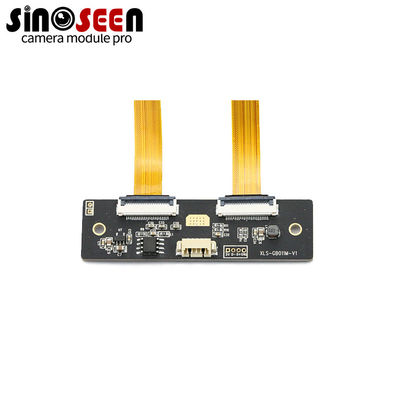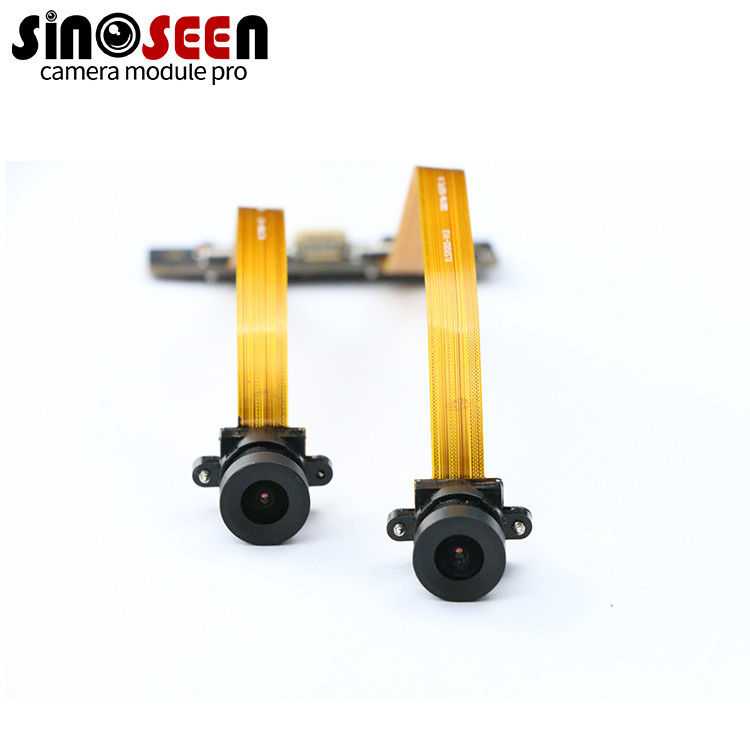Flexible USB 2.0 Binocular Camera Module 720P 1MP OV7251 and OV9281 Cmos Sensor
Product Details:
| Place of Origin: | Shenzhen,China |
| Brand Name: | Sinoseen |
| Certification: | RoHS |
| Model Number: | XLS-GB012M-V1 |
Payment & Shipping Terms:
| Minimum Order Quantity: | 3 |
|---|---|
| Price: | negotiable |
| Packaging Details: | Tray+Anti-static bag in carton box |
| Delivery Time: | 2-3weeks |
| Payment Terms: | T/T |
| Supply Ability: | 500000 pieces/month |
|
Detail Information |
|||
| Type: | USB Camera Module | Sensor: | OV7251 And OV9281 |
|---|---|---|---|
| Resolution: | 1MP 1280(H) X 720(V) | Dimensions: | 37.3mm*12mm(customizable) |
| Lens FOV: | 100°(optional) | Focus Type: | Fixed Focus |
| Interface: | USB2.0 | Feature: | Flexible |
| Highlight: | 720P 1MP Binocular Camera Module,Flexible Binocular Camera Module,720P NT99141 HD Camera Module |
||
Product Description
Flexible USB 2.0 Binocular Camera Module 720P 1MP OV7251 and OV9281 Cmos Sensor
This is our newly developed camera module, using a high-performance OV7251 and OV9281 CMOS sensor with a resolution of HD 720. Unlike most other camera modules, this module consists of two parts: a rigid part with a chip and a flexible part with a lens, so that it can be installed in a machine or equipment more easily.
The size of the rigid part is 37.3mm * 12mm, and the length of the flexible cable is 45mm. We can extend or shorten it according to your requirements. We provide a variety of FOV lenses for you to choose from, from 60° to 160°.
This module is widely used in DV, AR, VR, video, AI, wearable devices, Internet of Things, machine vision, computer vision,
Industrial, medical, endoscopy, robotics, vision, etc.
Specification
|
Model No |
XLS-GB012M-V1 |
|
Sensor |
OV7251 and OV9281 |
|
Pixel |
1 Mega Pixel |
|
Most effective pixels |
1280(H) x 720(V) |
|
Pixel Size |
3.0µm x 3.0µm |
|
Image area |
3852um(H) x 2172um (V) |
|
Compression format |
MJPEG / YUV2 (YUYV) |
|
Resolution & Frame rate |
See above |
|
Shutter Type |
Electronic rolling shutter |
|
Focus type |
Fixed focus |
|
ADC Resolution |
10 bits |
|
Object distance |
10CM-Infinity |
|
Minimum Illumination |
0.1 Lux |
|
Interface type |
USB2.0 high speed |
|
Adjustable parameter |
Brightness/Contrast/Color saturation/Hue/Definition/ |
|
Lens |
EFL: 2.3mm |
|
|
Lens Size: 1/4 inch |
|
|
H FOV: 100° |
|
|
Lens Construction: 4G+IR |
|
Audio frequency |
Optional |
|
Power supply |
USB BUS POWER |
|
Power consumption |
DC 5V, 120mA |
|
Main chip |
DSP/SENSOR/FLASH |
|
Auto Exposure Control (AEC) |
Support |
|
Auto White Balance (AEB) |
Support |
|
Auto Gain Control (AGC) |
Support |
|
Dimension |
37.3mm*12mm |
|
Storage temperature |
-20°C to 70°C |
|
Operating temperature |
0°C to 60°C |
|
USB cable length |
Default |
|
Support OS |
WinXP/Vista/Win7/Win8/Win10 |
![]()
Shenzhen Sinoseen Technology Co.,Ltd
China top 10 camera module manufacturer
We customize all kinds of USB/MIPI/DVP camera module as per your request
Camera module customization process
1 According to the actual application scenarios and functional goals, the camera module needs to comprehensively consider the product structure size, image clarity, frame rate, lens angle, lighting scene and other factors to select the appropriate sensor, lens and solution. needs customization. These products are only used for customer testing DEMO, please contact our customer service to inform you which product you want to use the camera module on? What function is implemented? Are there any special requirements? According to cost targets and other comprehensive factors, we help you choose the right SENSER+ lens solution, and then design the product PCB or FPC according to the structural requirements.
2 examples: the customer is going to make a person recognition and comparison machine. If it is used in a well-lit indoor environment, we recommend that customers use ordinary lenses and sensors. If the light or backlight is not good, we recommend customers to use WDR wide dynamic sensor. If customers have high requirements for safety, we recommend that customers use WDR and black and white infrared binocular recognition camera modules. When determining the sensor and lens plan, the customer should adjust the color, white balance and saturation parameters according to the actual environment to achieve the target effect.








